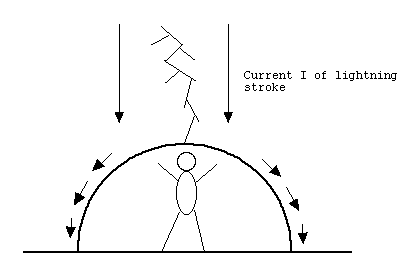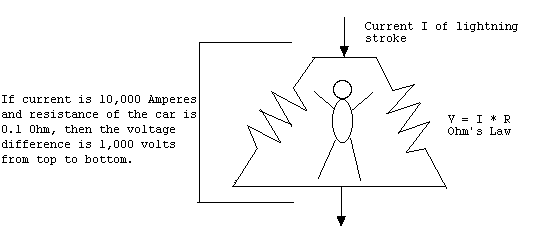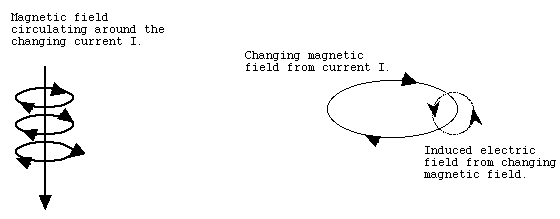MadSci Article 2
Here is some general information about lightning: Lightning Informationn
Here is a simple diagram of how the current from a lightning bolt might flow through the metallic body of a car while a person that is inside the car is relatively safe with no current flowing through them. There might be millions of volts of potential and thousands of amperes of current in the lightning bolt, but since the body of a car is usually a much better conductor of electricity than a human body, the electricity of the bolt prefers to travel through the metal of the car rather than through the occupant.
 The above explanation is mostly correct but incomplete. There are two
concepts of physics that should be considered to get a more complete
picture of what is going on. These concepts are Ohm's Law and
induced EMF.
Ohm's Law states that voltage equals current times resistance, or that
V = I * R. What this law means is that when electricity flows through
something there is a voltage different between one end of the thing and
the other end. The bigger the flow, the bigger the voltage. Also, the
bigger the resistance to flow, the bigger the voltage.
For a lightning bolt, the average current might be 50 amperes. However
there can be peak currents of 10,000 amperes that only last for a
very short time, like a millisecond. Also, even though a car is made
of metal it is not a perfect conductor, there will be some resistance.
I am guessing here, but it might be 0.1 Ohms (one tenth of an Ohm.)
If you multiple 10,000 amperes by 0.1 Ohms you get 1000 volts. This is
a voltage that will appear between the point where the lightning bolt
hits the car and the point where it leaves the car.
The above explanation is mostly correct but incomplete. There are two
concepts of physics that should be considered to get a more complete
picture of what is going on. These concepts are Ohm's Law and
induced EMF.
Ohm's Law states that voltage equals current times resistance, or that
V = I * R. What this law means is that when electricity flows through
something there is a voltage different between one end of the thing and
the other end. The bigger the flow, the bigger the voltage. Also, the
bigger the resistance to flow, the bigger the voltage.
For a lightning bolt, the average current might be 50 amperes. However
there can be peak currents of 10,000 amperes that only last for a
very short time, like a millisecond. Also, even though a car is made
of metal it is not a perfect conductor, there will be some resistance.
I am guessing here, but it might be 0.1 Ohms (one tenth of an Ohm.)
If you multiple 10,000 amperes by 0.1 Ohms you get 1000 volts. This is
a voltage that will appear between the point where the lightning bolt
hits the car and the point where it leaves the car.
 The 1000 volts will be present between the top and the bottom of the
car if the lightning hits the top of the car and exits out the bottom.
This 1000 volts will be present even though all the current of the
lightning is flowing through the car body. If you were in the car and
touching the roof with your hand and also touching the metal near the
bottom of the car when the lightning hit, there would be a brief moment
when 1000 volts would be trying to push electricity through your body.
The time would be brief, about 0.001 seconds, so the energy would be
fairly small, about 0.01 joules. This would not be enough to burn you
but it could interfere with your heart contractions. I would not want
to experience this myself.
There is another way that lightning could hurt you even while you are
sitting in the car. This is through induced EMF. Any rapidly changing
electrical current will produce a rapidly changing magnetic field.
Magnetic fields are generally harmless, however a rapidly changing
magnetic field will in turn produce an electric field. If the electric
field is induced in a conductor, like the human body, it will cause a
circulating current to flow. In a sense, the path of the lightning
bolt is like a radio transmitter, and the body could act like a
receiving antenna.
The 1000 volts will be present between the top and the bottom of the
car if the lightning hits the top of the car and exits out the bottom.
This 1000 volts will be present even though all the current of the
lightning is flowing through the car body. If you were in the car and
touching the roof with your hand and also touching the metal near the
bottom of the car when the lightning hit, there would be a brief moment
when 1000 volts would be trying to push electricity through your body.
The time would be brief, about 0.001 seconds, so the energy would be
fairly small, about 0.01 joules. This would not be enough to burn you
but it could interfere with your heart contractions. I would not want
to experience this myself.
There is another way that lightning could hurt you even while you are
sitting in the car. This is through induced EMF. Any rapidly changing
electrical current will produce a rapidly changing magnetic field.
Magnetic fields are generally harmless, however a rapidly changing
magnetic field will in turn produce an electric field. If the electric
field is induced in a conductor, like the human body, it will cause a
circulating current to flow. In a sense, the path of the lightning
bolt is like a radio transmitter, and the body could act like a
receiving antenna.
 The induced EMF should not be a problem except when the lightning
current flows close by. Of course, if you are in a car that is hit
by lightning, the current is very close by! There is a factor that
does help reduce the danger in the car. The fact that the current will
flow fairly evenly throughout the body of the car means that there will
be cancellation of the induced EMF due to oppositely located currents
in the car body. The EMF from current flowing down the left side of
the car should cancel the EMF from current flowing down the right side
of the car. However, since cars are not perfectly symmetrical, the
cancellation won't be perfect. Also, since the EMF is in what is
called the "near field" region, the cancellation is only 100% effective
in the exact center of the current flow. The closer a person is to
the sides of the car the greater the induced EMF they will experience.
Like the case with the Ohm's Law scenario, the amount of energy that is
potentially delivered to the occupant of the car is fairly small, not
enough to cause a burn. However, the circulating induced current could
interfere with the heart action. Here is an article that describes
how the induced EMF effect may explain the mysterious deaths of some
hikers:
Article about mysterious deaths possibly related to lightning
The induced EMF should not be a problem except when the lightning
current flows close by. Of course, if you are in a car that is hit
by lightning, the current is very close by! There is a factor that
does help reduce the danger in the car. The fact that the current will
flow fairly evenly throughout the body of the car means that there will
be cancellation of the induced EMF due to oppositely located currents
in the car body. The EMF from current flowing down the left side of
the car should cancel the EMF from current flowing down the right side
of the car. However, since cars are not perfectly symmetrical, the
cancellation won't be perfect. Also, since the EMF is in what is
called the "near field" region, the cancellation is only 100% effective
in the exact center of the current flow. The closer a person is to
the sides of the car the greater the induced EMF they will experience.
Like the case with the Ohm's Law scenario, the amount of energy that is
potentially delivered to the occupant of the car is fairly small, not
enough to cause a burn. However, the circulating induced current could
interfere with the heart action. Here is an article that describes
how the induced EMF effect may explain the mysterious deaths of some
hikers:
Article about mysterious deaths possibly related to lightningIn summary, a car is not a perfectly safe place from lightning. The rubber tires really do not have anything to do with the protection that you get inside of a car. The lightning bolt has probably sparked across a mile of air already by the time it reaches a car. If the car is hit by an especially strong bolt, there will be significant, though probably not fatal, electrical effects on the occupants inside the car. Still, a car is a much better place to be than almost any other place that I can think of. Regards, Everett Rubel